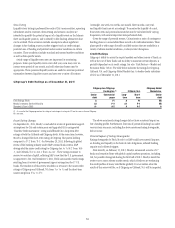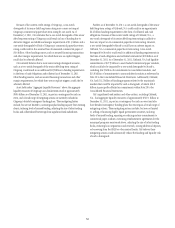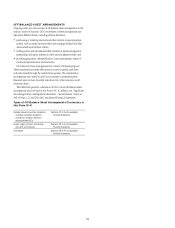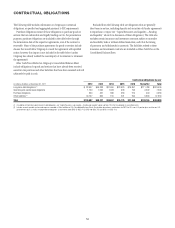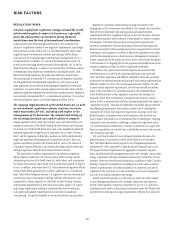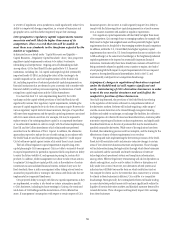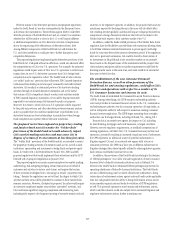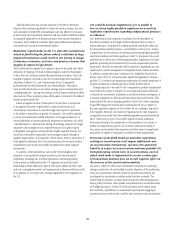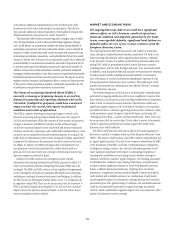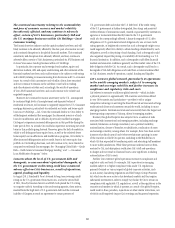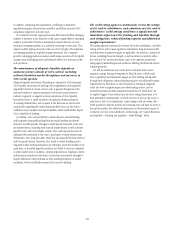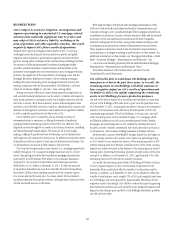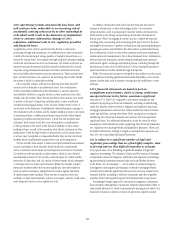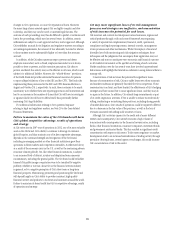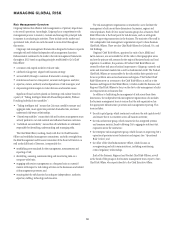Citibank 2011 Annual Report Download - page 83
Download and view the complete annual report
Please find page 83 of the 2011 Citibank annual report below. You can navigate through the pages in the report by either clicking on the pages listed below, or by using the keyword search tool below to find specific information within the annual report.61
In addition, complying with inconsistent, conflicting or duplicative
regulations requires extensive time and effort and further increases Citi’s
compliance, regulatory and other costs.
It is uncertain how the ongoing Eurozone debt crisis will affect emerging
markets. A recession in the Eurozone could cause a ripple effect in emerging
markets, particularly if banks in developed economies decrease or cease
lending to emerging markets, as is currently occurring in some cases. This
impact could be disproportionate in the case of Citi in light of the emphasis
on emerging markets in its global strategy. Decreased, low or negative
growth in emerging market economies could make execution of Citi’s global
strategy more challenging and could adversely affect Citi’s revenues, profits
and operations.
The maintenance of adequate liquidity depends on
numerous factors outside of Citi’s control, including
without limitation market disruptions and increases in
Citi’s credit spreads.
Adequate liquidity and sources of funding are essential to Citi’s businesses.
Citi’s liquidity and sources of funding can be significantly and negatively
impacted by factors it cannot control, such as general disruptions in the
financial markets or negative perceptions about the financial services
industry in general, or negative investor perceptions of Citi’s liquidity,
financial position or credit worthiness in particular. Market perception
of sovereign default risks, such as issues in the Eurozone as well as other
complexities regarding the current European debt crisis, can also lead to
ineffective money markets and capital markets, which could further impact
Citi’s availability of funding.
In addition, Citi’s cost and ability to obtain deposits, secured funding
and long-term unsecured funding from the capital markets are directly
related to its credit spreads. Changes in credit spreads constantly occur and
are market-driven, including both external market factors as well as factors
specific to Citi, and can be highly volatile. Citi’s credit spreads may also be
influenced by movements in the costs to purchasers of credit default swaps
referenced to Citi’s long-term debt, which are also impacted by these external
and Citi-specific factors. Moreover, Citi’s ability to obtain funding may be
impaired if other market participants are seeking to access the markets at the
same time, or if market appetite is reduced, as is likely to occur in a liquidity
or other market crisis. In addition, clearing organizations, regulators, clients
and financial institutions with which Citi interacts may exercise the right to
require additional collateral based on these market perceptions or market
conditions, which could further impair Citi’s access to funding.
The credit rating agencies continuously review the ratings
of Citi and its subsidiaries, and reductions in Citi’s and its
subsidiaries’ credit ratings could have a significant and
immediate impact on Citi’s funding and liquidity through
cash obligations, reduced funding capacity and additional
margin requirements.
The rating agencies continuously evaluate Citi and its subsidiaries, and their
ratings of Citi’s and its more significant subsidiaries’ long-term/senior debt
and short-term /commercial paper, as applicable, are based on a number of
factors, including financial strength, as well as factors not entirely within
the control of Citi and its subsidiaries, such as the agencies’ proprietary
rating agency methodologies and conditions affecting the financial services
industry generally.
Citi and its subsidiaries may not be able to maintain their current
respective ratings. Ratings downgrades by Fitch, Moody’s or S&P could
have a significant and immediate impact on Citi’s funding and liquidity
through cash obligations, reduced funding capacity and additional margin
requirements for derivatives or other transactions. Ratings downgrades
could also have a negative impact on other funding sources, such as
secured financing and other margined transactions, for which there are
no explicit triggers. Some entities may also have ratings limitations as to
their permissible counterparties, of which Citi may or may not be aware. A
reduction in Citi’s or its subsidiaries’ credit ratings could also widen Citi’s
credit spreads or otherwise increase its borrowing costs and limit its access to
the capital markets. For additional information on the potential impact of
a reduction in Citi’s or its subsidiaries’ credit ratings, see “Capital Resources
and Liquidity—Funding and Liquidity—Credit Ratings” above.


